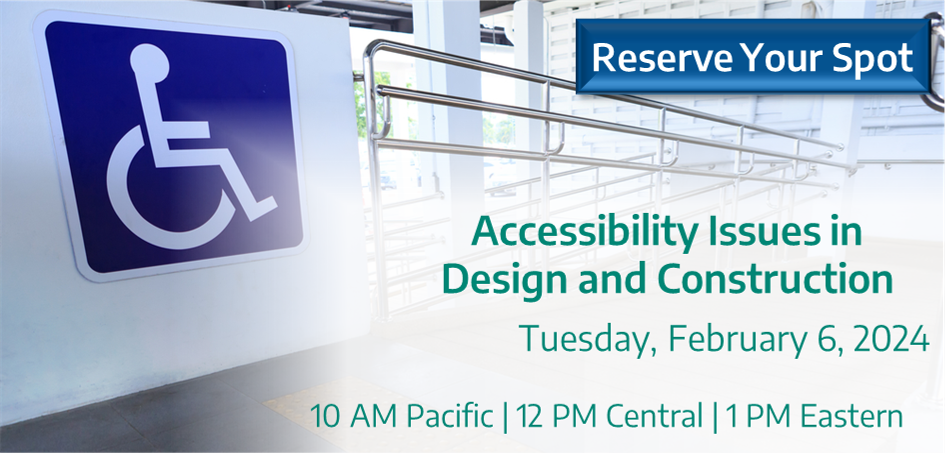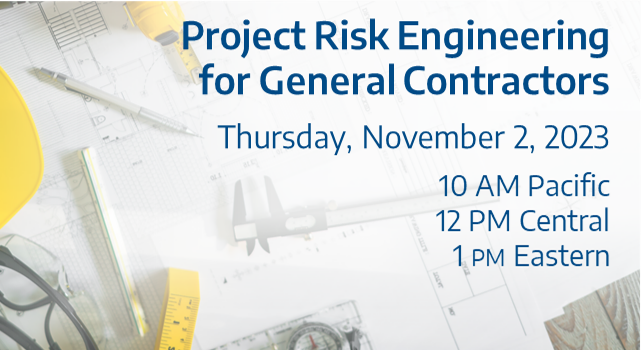
Presenters:
Andrew D. Mendelson, FAIA, Berkley Construction Professional, EVP, Chief Risk Management & CX Officer
Timothy Brashear, P.E., Officer & VP Construction Services, Rimkus
Date: Tuesday, May 14, 2024
Time: 1:00-2:00 p.m. EST

Presenters:
Andrew D. Mendelson, FAIA, Berkley Construction Professional, EVP, Chief Risk Management & CX Officer
Timothy Brashear, P.E., Officer & VP Construction Services, Rimkus
Date: Tuesday, May 14, 2024
Time: 1:00-2:00 p.m. EST

Presented By:
Ryan Jenkins, CSP, WSJ Bestselling Author & Speaker, RyanJenkins.com
Diane P. Mika, Senior Vice President, Risk Management Officer, Berkley Alliance Managers
Wednesday, May 15, 2024
10:00 a.m. to 11:00 a.m. Pacific Daylight Time

Presented by:
David Pacifici, CIC, CRM, RPLU, Senior Vice President, Berkley Construction Professional
Andrew D. Mendelson, EVP, Chief Risk Management Officer, Berkley Alliance Managers
Wednesday March 6, 2024
10 - 11 AM Pacific
12 - 1 PM Central
1 - 2 PM Eastern

Presented by:
Andrew D. Mendelson, FAIA, Executive Vice President, Chief Risk Management Officer, Berkley Alliance Managers
Andrew D. Mendelson, FAIA, Executive Vice President, Chief Risk Management Officer, Berkley Alliance Managers
Scott R. Samolovitch, Esq., Associate, Burke Cromer Cremonese, LLC

Presented by:
Timothy R. Brashear, P.E. ret., Officer and Vice President Construction Services, Rimkus
Andrew D. Mendelson, FAIA, Executive Vice President, Chief Risk Management Officer, Berkley Design Professional
Thursday, November 2, 2023
10:00 a.m. to 11:00 a.m. Pacific Daylight Time

By David Pacifici | Monday, April 25, 2022
Design-build delivery carries much greater risk to a contractor than conventional project delivery methods. Chief among these risks is the potential for increased actual or final costs to a general contractor or design-build entity compared to the estimates presented in their bid. The result is that many contractors using design-build are experiencing lower profitability or even taking losses.
In addition, contractors are making claims against their prime engineering subconsultants and the mitigation coverage in their contractor’s professional liability (CPrL) insurance at a much higher frequency and severity than the subconsultants and insurers had anticipated.

By Janice Greenberg | Monday, January 3, 2022
Construction professionals undoubtedly engage in a call or email conversation at least once a year with their insurance broker to discuss the company’s insurance coverages. Typically, these conversations center around whether to renew the company’s existing policies with its current insurance carriers or purchase policies from new insurance carriers. Sometimes, these conversations also explore whether the company is adequately insured for foreseeable risks. For general contractors and subcontractors, the focus is usually on the coverages typically required under the terms of your contracts, such as general liability, automobile liability and workers’ compensation coverage; indeed, these insurance policies should address any curveballs that might get tossed at the company during the course of a project.

By David Pacifici | Sunday, November 7, 2021
Many recent public or quasi-public projects that have utilized design-build as a project delivery method have experienced significant insurance claims due to schedule delays or cost overruns.

By Peter Brooks | Monday, August 16, 2021
The typical formula for running a successful construction and contracting business is a mixture of vision with hard work, investment and experience. But then, there’s always the unexpected — just ask the thousands of construction firms that either had projects shuttered or delayed once COVID-19 took hold in 2020. In fact, a recent survey by the Associated General Contractors of America (AGC) found that 75% of contractors had projects canceled or postponed due to the pandemic.

By Olivia Overman | Monday, August 2, 2021
Prior to the coronavirus pandemic, the professional liability market was firming across most lines of business due to loss severity. Over the past 18 months, as the economy experienced widespread layoffs, bankruptcies and cyber breaches stemming from the COVID-19 pandemic, the market was adversely impacted even further.